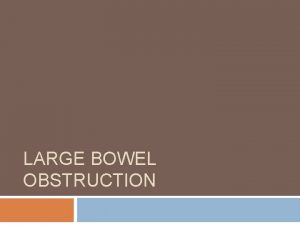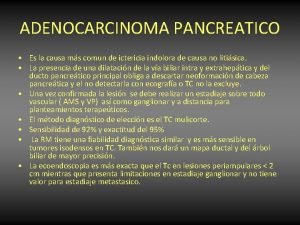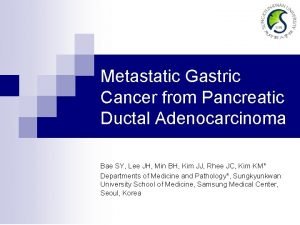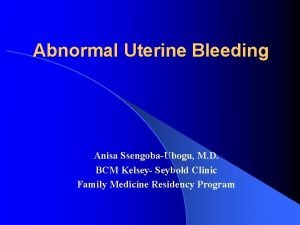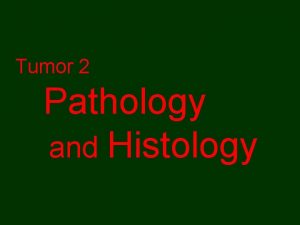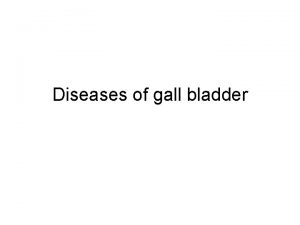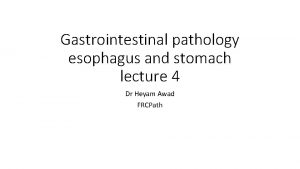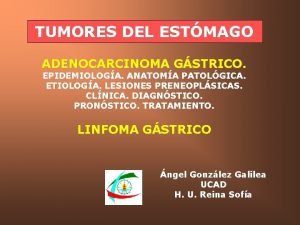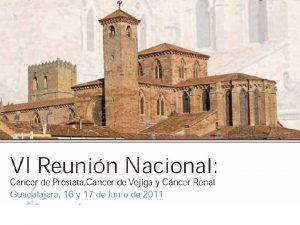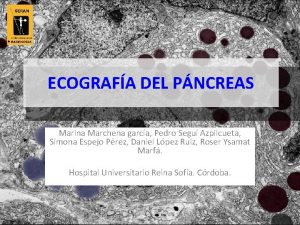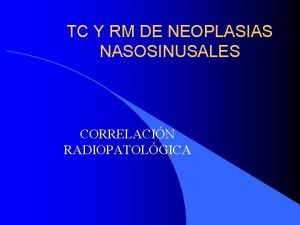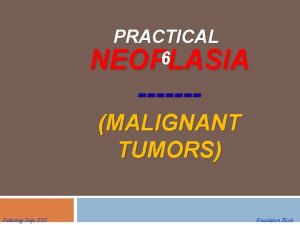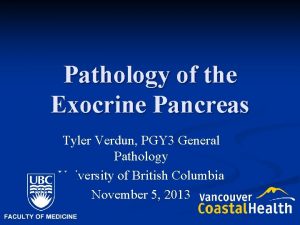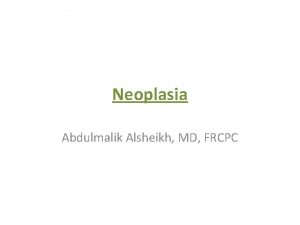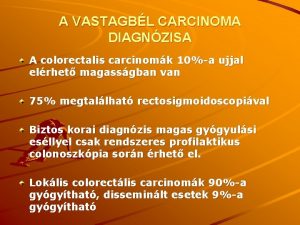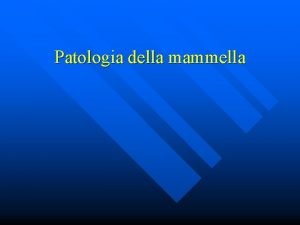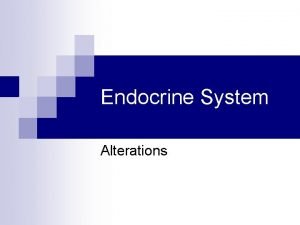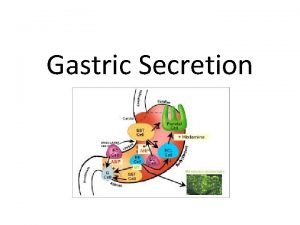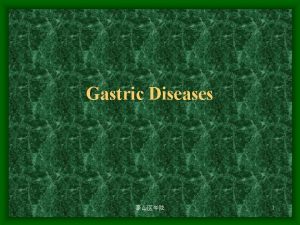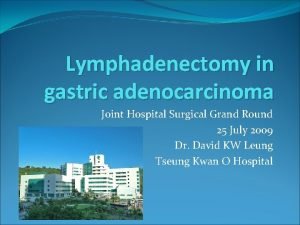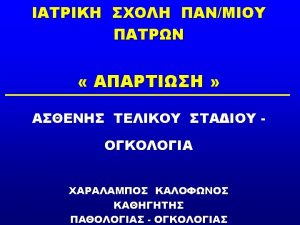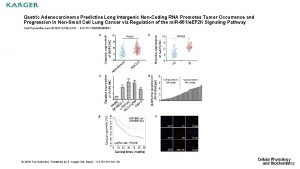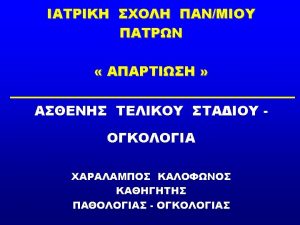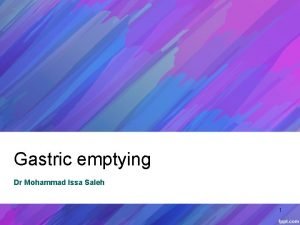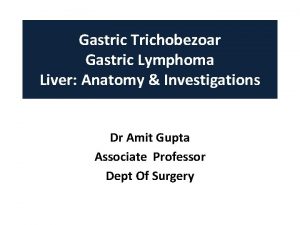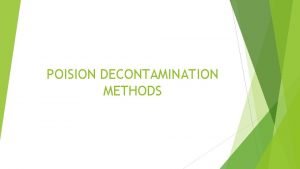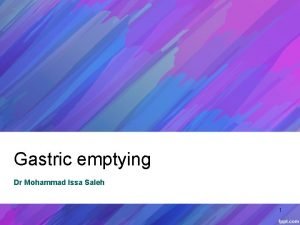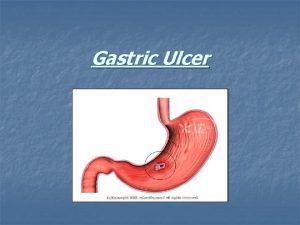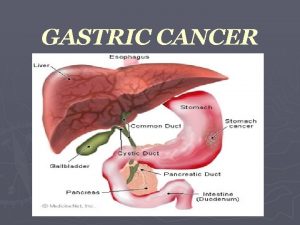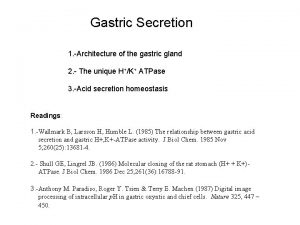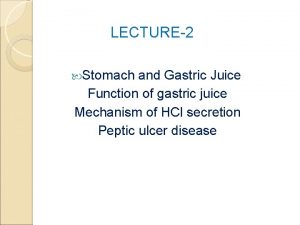GASTRIC CARCINOMA Pathophysiology Adenocarcinoma characterized as intestinal or




















- Slides: 20

GASTRIC CARCINOMA

Pathophysiology • Adenocarcinoma characterized as intestinal or diffuse • Spreads through stomach into the gastric wall to the – – – – – Lymph nodes Liver Pancreas Transverse colon Omentum Peritoneum Ovaries Pelvic cul-de-sac Through portal vein into lungs, liver, and bone Advanced stage: stomach muscle

Etiology • H. pylori: 80 percent of gastric carcinomas result from H. pylori due to the result of free radicals • Dietary nitrates (bacteria in stomach breaks down nitrites to compounds that are carcinogenic in animals) • Hypochlorhydria: occurs in gastric atrophy and promotes bacterial growth in stomach • Foods such as starch, pickled vegetables, salted fish and meat, smoked foods and salt • People who smoke cigarettes or use alcohol are 3 -5 times more likely

Etiology cont. • • Epstein-Barr virus is now implicated as a cause Pernicious anemia Chronic atrophic gastritis Gastric polyp Achlorhydria Barrett’s esophagus Having had a Billroth 2 procedure Genetic factors include: – First degree relatives – Type A blood

Incidence/Prevalence • 3 rd most common GI malignancy (after colorectal and pancreatic) • 14 th cause of cancer related death in U. S. • 85 -95% are caused by adenocarcinoma • 15% are caused by Non-Hodgkin’s lymphoma & leiomysosarcomas

Anatomy of the stomach

location • • 37% in the proximal third of the stomach 30% in the distal stomach 20% in the midsection Remaining 13% in the entire stomach

Onset • • • Insidious (slowly developing) Usually discovered in advanced stages Men>Women Occurs between the ages of 50 -70 Increased mortality in – – – Japanese Costa Ricans Chileans Native Americans African Americans Scandinavians

Assessment • History: – High risk foods – Alcohol/tobacco use – Treated for H. Pylori infection – Gastritis, pernicious anemia, gastric surgery, polyps – Immediate family dx gastric cancer – Blood type

Physical Assessment • Early gastric cancer – Indigestion – Abdominal discomfort initially relieved with antacids – Feeling of fullness – Epigastric, back, or retrosternal pain – NOTE: most people will show no clinical manifestations

Physical Assessment cont. • Advanced stage: – Nausea/vomiting – Obstructive symptoms – Iron deficiency/anemia – Palpable epigastric mass – Enlarged lymph nodes – Weakness/fatigue – Progressive weight loss

Labs • Decreased hematocrit and hemoglobin • Macrocytic or microcytic anemia (decreased vit. B 12 and iron absorption) • Stool positive for occult blood In Advanced stages: • Hypoalbuminemia • Bilirubin and alkaline phosphate will be abnormal • Increased level of carcinoembryonic antigen

Radiographic assessment • • • Double contrast upper GI series C. T. Esophagogastroduodenoscopy (EGD) Endoscopic ultrasound (EUS) Other findings include – Polypoid mass – Ulcer crater – Thickened fibrotic gastric wall

Interventions • Meds: chemotherapy – Fluruorouracil (5 -FU) – Doxorubicin – Mitomycin-C – Cisplatin – Etopide (best results when used in combination with each other) Side Effects include nausea/vomiting and bone marrow suppression

Interventions cont. • Radiation – Used most commonly for pre-op – Used in specific hospitals for intra-op – Does not increase survival after operations Side Effects include skin integrity, fatigue, anorexia, and diarrhea

Surgical Interventions • Surgery is the preferred method of treatment – Curative: Total gastrectomy Subtotal gastrectomy – Palliative: To relieve patients pain and ease their suffering

Nursing Interventions • Teach: – – – – – s/s of dumping syndrome Eat small, frequent meals No liquids with meals (one hour before or after) Increase protein, fat, and caloric intake Decrease carbohydrates Increase Iron, Vit B 12, and folate Dressing changes Side effects of chemo/radiation Always provide emotional support

Gastric Carcinoma

Questions? • True or False: Lab findings have shown stool positive for occult blood, decreased hematocrit and hemoglobin, and hypoalbuminemia in patients with gastric carcinoma • True or False: Most people will show many signs and symptoms indicating gastric cancer • True or False: People who have had gastritis are at a higher risk of developing gastric ca.

Grading Criteria • Joint effort by Elaine M. Lund and Monique Kolin
 Closed loop large bowel obstruction
Closed loop large bowel obstruction Pathophysiology of intestinal obstruction
Pathophysiology of intestinal obstruction Signo del doble conducto
Signo del doble conducto Adenocarcinoma
Adenocarcinoma Neoplasia
Neoplasia Endometrial adenocarcinoma
Endometrial adenocarcinoma Prostatic adenocarcinoma
Prostatic adenocarcinoma Muscle layer
Muscle layer Intestinal
Intestinal Clasificacion borrmann
Clasificacion borrmann Prostatic adenocarcinoma
Prostatic adenocarcinoma Adenocarcinoma acinar de prostata
Adenocarcinoma acinar de prostata Adenocarcinoma pancreatico
Adenocarcinoma pancreatico Plasmocitoma
Plasmocitoma Adenocarcinoma
Adenocarcinoma Pancreatic carcinoma risk factors
Pancreatic carcinoma risk factors Carcinoma in situ
Carcinoma in situ Sti
Sti Carcinoma epidermoide
Carcinoma epidermoide Carcinoma comedonico
Carcinoma comedonico Hormone
Hormone
